Heat Transfer Enhancement in the Microscale: Optimization of Fluid Flow
Abstract
1. Introduction
2. Brief Review on Optimization of Effects of Nanoparticles
2.1. Effects of Nanoparticles on Thermal Conductivity
2.2. Effects of Nanoparticles on Viscosity
2.3. Effects of Flow Regime on the Heat Transfer Coefficient
2.4. Optimization of Thermal Conductivity and Viscosity Effects on Heat Transfer Coefficient
3. Experimental Setup
4. Materials and Methods
4.1. Nanofluid Synthesis
4.2. Heat Transfer Measurement
5. Results and Discussion
6. Conclusions
Author Contributions
Funding
Data Availability Statement
Conflicts of Interest
Appendix A
| Symbol | Definition | Units |
|---|---|---|
| Thermal conductivity | (W/m·K) | |
| Dynamic viscosity | (kg/m·s) | |
| Density | (kg/m3) | |
| Volume concentration of nanoparticles | (-) | |
| Specific heat | (J/kg·K) | |
| Weight concentration of nanoparticles | (-) | |
| Heat flux | (W/m2) | |
| Mass flow rate | (kg/s) | |
| Temperature | (K) | |
| Surface area | (m2) | |
| Microchannel diameter | (m) | |
| Distance from inlet | (m) | |
| Heat transfer coefficient | (W/m2·K) | |
| Subscripts | ||
| Nanofluid | ||
| Nanoparticle | ||
| Base fluid | ||
| Fluid | ||
| Surface |
References
- Xuan, Y.; Li, Q. Heat transfer enhancement of nanofluids. Int. J. Heat Fluid Flow 2000, 21, 58–64. [Google Scholar] [CrossRef]
- Ebrahimnia-Bajestan, E.; Charjouei Moghadam, M.; Niazmand, H.; Daungthongsuk, W.; Wongwises, S. Experimental and numerical investigation of nanofluids heat transfer characteristics for application in solar heat exchangers. Int. J. Heat Mass Transf. 2016, 92, 1041–1052. [Google Scholar] [CrossRef]
- Ding, Y.; Chen, H.; He, Y.; Lapkin, A.; Yeganeh, M.; Šiller, L.; Butenko, Y.V. Forced convective heat transfer of nanofluids. Adv. Powder Technol. 2007, 18, 813–824. [Google Scholar] [CrossRef]
- Chen, H.; Yang, W.; He, Y.; Ding, Y.; Zhang, L.; Tan, C.; Lapkin, A.A.; Bavykin, D.V. Heat transfer and flow behaviour of aqueous suspensions of titanate nanotubes (nanofluids). Powder Technol. 2008, 183, 63–72. [Google Scholar] [CrossRef]
- Demirkir, C.; Erturk, H. Convective heat transfer and pressure drop characteristics of graphene-water nanofluids in transitional flow. Int. Commun. Heat Mass Transf. 2021, 121, 105092. [Google Scholar] [CrossRef]
- Raju, C.S.; Ibrahim, S.M.; Anuradha, S.; Priyadharshini, P. Bio-convection on the nonlinear radiative flow of a Carreau fluid over a moving wedge with suction or injection. Eur. Phys. J. Plus 2016, 131, 409. [Google Scholar] [CrossRef]
- Upadhya, S.M.; Mahesha; Raju, C. Cattaneo -Christov heat flux model for magnetohydrodynamic flow in a suspension of dust particles towards a stretching sheet. Nonlinear Eng. 2018, 7, 237–246. [Google Scholar] [CrossRef]
- Ge-JiLe, H.; Shah, N.A.; Mahrous, Y.; Sharma, P.; Raju, C.; Upddhya, S. Radiated magnetic flow in a suspension of ferrous nanoparticles over a cone with Brownian motion and thermophoresis. Case Stud. Therm. Eng. 2021, 25, 100915. [Google Scholar] [CrossRef]
- Priyadharshini, P.; Archana, M.V.; Ahammad, N.A.; Raju, C.; Yook, S.j.; Shah, N.A. Gradient descent machine learning regression for MHD flow: Metallurgy process. Int. Commun. Heat Mass Transf. 2022, 138, 106307. [Google Scholar] [CrossRef]
- Raju, C.; Ahammad, N.A.; Sajjan, K.; Shah, N.A.; Yook, S.J.; Kumar, M.D. Nonlinear movements of axisymmetric ternary hybrid nanofluids in a thermally radiated expanding or contracting permeable Darcy walls with different shapes and densities: Simple linear regression. Int. Commun. Heat Mass Transf. 2022, 135, 106110. [Google Scholar] [CrossRef]
- Barako, M.T.; Gambin, V.; Tice, J. Integrated nanomaterials for extreme thermal management: A perspective for aerospace applications. Nanotechnology 2018, 29, 154003. [Google Scholar] [CrossRef] [PubMed]
- Kumar, A.; Jeyan, J.V.M.L.; Anwar, A.A.; Khan, S.; Chamoli, A. Density of kerosene aluminium nanofluid used for regenerative cooling applications of thrust chambers. Int. J. Eng. Adv. Technol. 2019, 9, 176–180. [Google Scholar] [CrossRef]
- Ungar, E.; Erickson, L. Assessment of the use of nanofluids in spacecraft active thermal control systems. In Proceedings of the AIAA SPACE 2011 Conference Exposition, Long Beach, CA, USA, 27–29 September 2011. [Google Scholar] [CrossRef]
- Vajjha, R.S.; Das, D.K. Experimental determination of thermal conductivity of three nanofluids and development of new correlations. Int. J. Heat Mass Transf. 2009, 52, 4675–4682. [Google Scholar] [CrossRef]
- Sundar, L.; Singh, M.K.; Sousa, A.C. Investigation of thermal conductivity and viscosity of Fe3O4 nanofluid for heat transfer applications. Int. Commun. Heat Mass Transf. 2013, 44, 7–14. [Google Scholar] [CrossRef]
- Jang, S.; Choi, S.U. Effects of various parameters on nanofluid thermal conductivity. J. Heat Transf. 2006, 129, 617–623. [Google Scholar] [CrossRef]
- Lee, S.; Choi, S.U.S.; Li, S.; Eastman, J.A. Measuring thermal conductivity of fluids containing oxide nanoparticles. J. Heat Transf. 1999, 121, 280–289. [Google Scholar] [CrossRef]
- Liu, M.; Lin, M.C.; Wang, C. Enhancements of thermal conductivities with Cu, CuO, and carbon nanotube nanofluids and application of MWNT/water nanofluid on a water chiller system. Nanoscale Res. Lett. 2011, 6, 297. [Google Scholar] [CrossRef] [PubMed]
- Afrand, M.; Toghraie, D.; Sina, N. Experimental study on thermal conductivity of water-based Fe3O4 nanofluid: Development of a new correlation and modeled by Artificial Neural Network. Int. Commun. Heat Mass Transf. 2016, 75, 262–269. [Google Scholar] [CrossRef]
- Liu, M.S.; Lin, M.; Huang, I.T.; Wang, C.C. Enhancement of thermal conductivity with carbon nanotube for nanofluids. Int. Commun. Heat Mass Transf. 2005, 32, 1202–1210. [Google Scholar] [CrossRef]
- Agarwal, R.; Verma, K.; Agrawal, N.K.; Duchaniya, R.K.; Singh, R. Synthesis, characterization, thermal conductivity and sensitivity of Cuo nanofluids. Appl. Therm. Eng. 2016, 102, 1024–1036. [Google Scholar] [CrossRef]
- Barbés, B.; Páramo, R.; Blanco, E.; Casanova, C. Thermal conductivity and specific heat capacity measurements of CuO nanofluids. J. Therm. Anal. Calorim. 2013, 115, 1883–1891. [Google Scholar] [CrossRef]
- Sundar, L.S.; Singh, M.K.; Sousa, A.C. Enhanced thermal properties of nanodiamond nanofluids. Chem. Phys. Lett. 2016, 644, 99–110. [Google Scholar] [CrossRef]
- Cakmak, N. The impact of surfactants on the stability and thermal conductivity of graphene oxide de-ionized water nanofluids. J. Therm. Anal. Calorim. 2019, 139, 1895–1902. [Google Scholar] [CrossRef]
- Li, X.; Zhu, D.; Wang, X.; Wang, N.; Gao, J.; Li, H. Thermal conductivity enhancement dependent ph and chemical surfactant for Cu-H2O nanofluids. Thermochim. Acta 2008, 469, 98–103. [Google Scholar] [CrossRef]
- Li, X.; Yuan, F.; Tian, W.; Dai, C.; Yang, X.; Wang, D.; Du, J.; Yu, W.; Yuan, H. Heat transfer enhancement of nanofluids with non-spherical nanoparticles: A Review. Appl. Sci. 2022, 12, 4767. [Google Scholar] [CrossRef]
- Chon, C.H.; Kihm, K.D.; Lee, S.P.; Choi, S.U. Empirical correlation finding the role of temperature and particle size for nanofluid(Al2O3) thermal conductivity enhancement. Appl. Phys. Lett. 2005, 87, 153107. [Google Scholar] [CrossRef]
- Kwek, D.; Crivoi, A.; Duan, F. Effects of temperature and particle size on the thermal property measurements of Al2O3 water nanofluids. J. Chem. I 2010, 55, 5690–5695. [Google Scholar] [CrossRef]
- Vafaei, S.; Yeager, J.; Daluga, P.; Scherer, B. Forced convection nanofluid heat transfer as a function of distance in microchannels. Materials 2021, 14, 3021. [Google Scholar] [CrossRef] [PubMed]
- Sekhar, Y.R.; Sharma, K. Study of viscosity and specific heat capacity characteristics of water-based Al2O3 nanofluids at low particle concentrations. J. Exp. Nanosci. 2015, 10, 86–102. [Google Scholar] [CrossRef]
- Esfe, M.H.; Esfandeh, S. Rheological behavior of CuO/EG:W (20:80 v/v) nanofluid from a thermal perspective. J. Therm. Anal. Calorim. 2019, 135, 61–72. [Google Scholar] [CrossRef]
- Chaitanya Lahari, M.; Sesha Talpa Sai, P.; Sharma, K.; Narayanaswamy, K.; Haseena Bee, P.; Devaraj, S. Analysis of parallel flow heat exchanger using SiO2 nanofluids in the laminar flow region. J. Phys. Conf. Ser. 2021, 2070, 012230. [Google Scholar] [CrossRef]
- Apmann, K.; Fulmer, R.; Soto, A.; Vafaei, S. Thermal Conductivity and Viscosity: Review and Optimization of Effects of Nanoparticles. Materials 2021, 14, 1291. [Google Scholar] [CrossRef] [PubMed]
- Sharma, M.; Gupta, M.; Katyal, P. Experimental Investigation on Viscosity of CuO/Water Nanofluid. Int. J. Res. Eng. Appl. Manag. 2018, 4, 271–277. [Google Scholar] [CrossRef]
- Ahammed, N.; Asirvatham Lazarus, G.; Wongwises, S. Effect of volume concentration and temperature on viscosity and surface tension of graphene-water nanofluid for heat transfer applications. J. Therm. Anal. Calorim. 2015, 123, 1399–1409. [Google Scholar] [CrossRef]
- Qiao, Y.; Sheng, W.; He, C.; Liu, C.; Rao, Z. Experimental study on the effect of different surfactants on the thermophysical properties of graphene filled nanofluids. Int. J. Energy Res. 2021, 45, 10043–10063. [Google Scholar] [CrossRef]
- Sayahi, T.; Bahrami, M. Investigation on the Effect of Type and Size of Nanoparticles and Surfactant on Pool Boiling Heat Transfer of Nanofluids. J. Heat Transf. 2016, 138, 031502. [Google Scholar] [CrossRef]
- Khairul, M.; Shah, K.; Doroodchi, E.; Azizian, R.; Moghtaderi, B. Effects of surfactant on stability and thermo-physical properties of metal oxide nanofluids. Int. J. Heat Mass Transf. 2016, 98, 778–787. [Google Scholar] [CrossRef]
- Minakov, A.V.; Rudyak, V.Y.; Pryazhnikov, M.I. Systematic experimental study of the viscosity of nanofluids. Heat Transf. Eng. 2020, 42, 1024–1040. [Google Scholar] [CrossRef]
- Zhu, D.; Wang, L.; Yu, W.; Xie, H. Intriguingly high thermal conductivity increment for CuO nanowires contained nanofluids with low viscosity. Sci. Rep. 2018, 8, 5282. [Google Scholar] [CrossRef]
- Main, K.; Eberl, B.; McDaniel, D.; Tikadar, A.; Paul, T.C.; Khan, J.A. Nanoparticles shape effect on viscosity and thermal conductivity of ionic liquids based nanofluids. In Proceeding of 5th Thermal and Fluids Engineering Conference (TFEC), New Orleans, LA, USA, 5–8 April 2020. [Google Scholar] [CrossRef]
- Apmann, K.; Fulmer, R.; Scherer, B.; Good, S.; Wohld, J.; Vafaei, S. Nanofluid heat transfer: Enhancement of the heat transfer coefficient inside microchannels. Nanomaterials 2022, 12, 615. [Google Scholar] [CrossRef]
- Godson, L.; Raja, B.; Mohan Lal, D.; Wongwises, S. Convective heat transfer characteristics of silver-water nanofluid under laminar and turbulent flow conditions. J. Therm. Sci. Eng. Appl. 2012, 4, 031001. [Google Scholar] [CrossRef]
- Zhang, L.; Zhang, A.; Jing, Y.; Qu, P.; Wu, Z. Effect of particle size on the heat transfer performance of SiO2-water nanofluids. J. Phys. Chem. 2021, 125, 13590–13600. [Google Scholar] [CrossRef]
- Liu, D.; Yu, L. Single-phase thermal transport of nanofluids in a minichannel. J. Heat Transf. 2010, 133, 031009. [Google Scholar] [CrossRef]
- Turgut, A.; Tavman, I.; Chirtoc, M.; Schuchmann, H.P.; Sauter, C.; Tavman, S. Thermal conductivity and viscosity measurements of water-based TiO2 nanofluids. Int. J. Thermophys. 2009, 30, 1213–1226. [Google Scholar] [CrossRef]
- Masuda, H.; Ebata, A.; Teramae, K.; Hishinuma, N. Alteration of thermal conductivity and viscosity of liquid by dispersing ultra-fine particles. dispersion of Al2O3, SiO2 and TiO2 ultra-fine particles. Netsu Bussei 1993, 7, 227–233. [Google Scholar] [CrossRef]
- Wang, Z.L.; Tang, D.W.; Liu, S.; Zheng, X.H.; Araki, N. Thermal-conductivity and thermal-diffusivity measurements of nanofluids by 3Ω method and mechanism analysis of Heat Transport. Int. J. Thermophys. 2007, 28, 1255–1268. [Google Scholar] [CrossRef]
- Hamid, K.; Azmi, W.; Mamat, R.; Usri, N.; Najafi, G. Effect of temperature on heat transfer coefficient of titanium dioxide in ethylene glycol-based nanofluid. J. Mech. Eng. Sci. 2015, 8, 1367–1375. [Google Scholar] [CrossRef]
- Zheng, D.; Wang, J.; Chen, Z.; Baleta, J.; Sunden, B. Performance analysis of a plate heat exchanger using various nanofluids. Int. J. Heat Mass Transf. 2020, 158, 119993. [Google Scholar] [CrossRef]
- Rea, U.; McKrell, T.; Hu, L.w.; Buongiorno, J. Laminar convective heat transfer and viscous pressure loss of alumina–water and Zirconia–water nanofluids. Int. J. Heat Mass Transf. 2009, 52, 2042–2048. [Google Scholar] [CrossRef]
- Mondragon, R.; Sanchez, D.; Cabello, R.; Llopis, R.; Julia, J.E. Flat plate solar collector performance using alumina nanofluids. PLoS ONE 2019, 14, 0212260. [Google Scholar] [CrossRef]
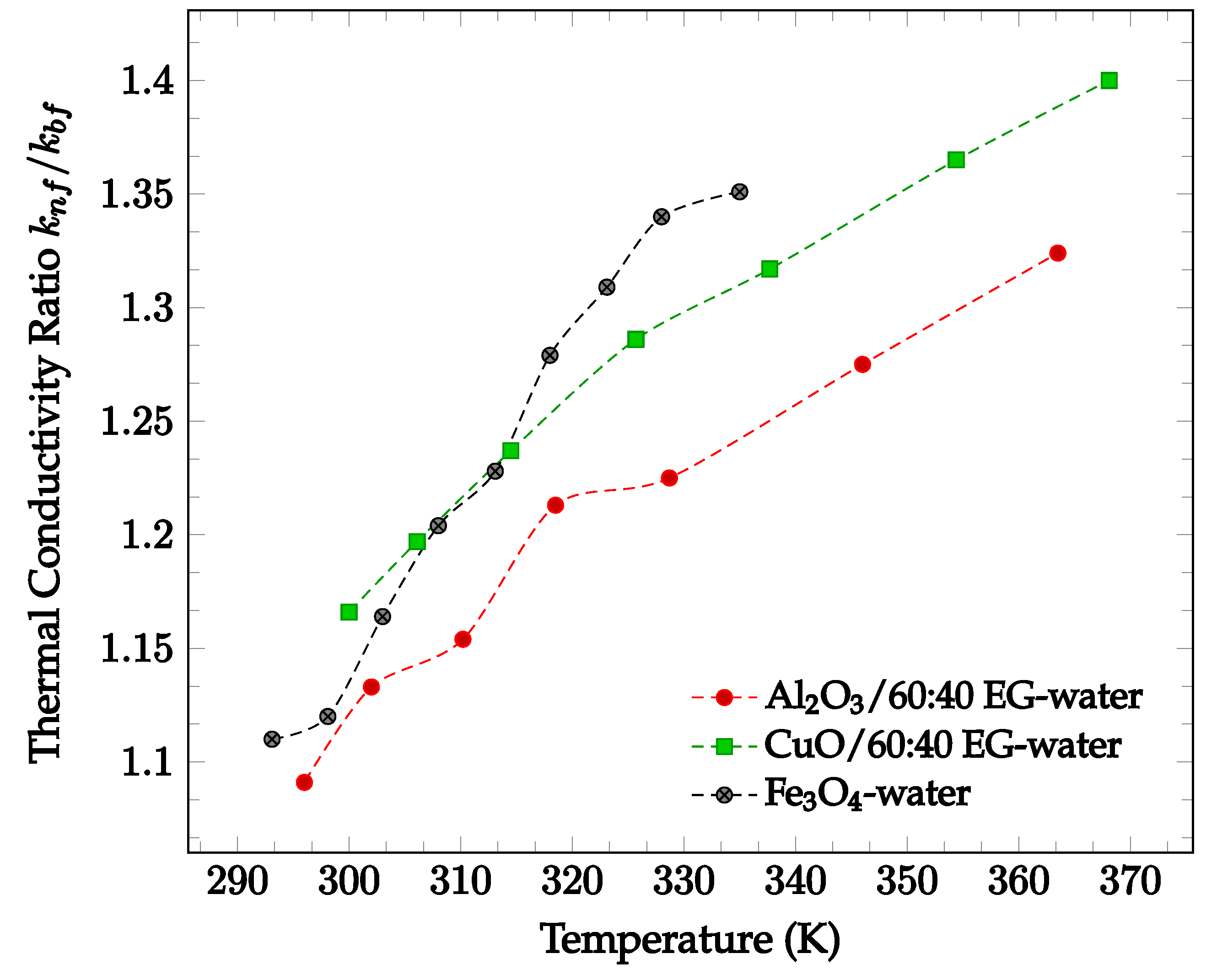

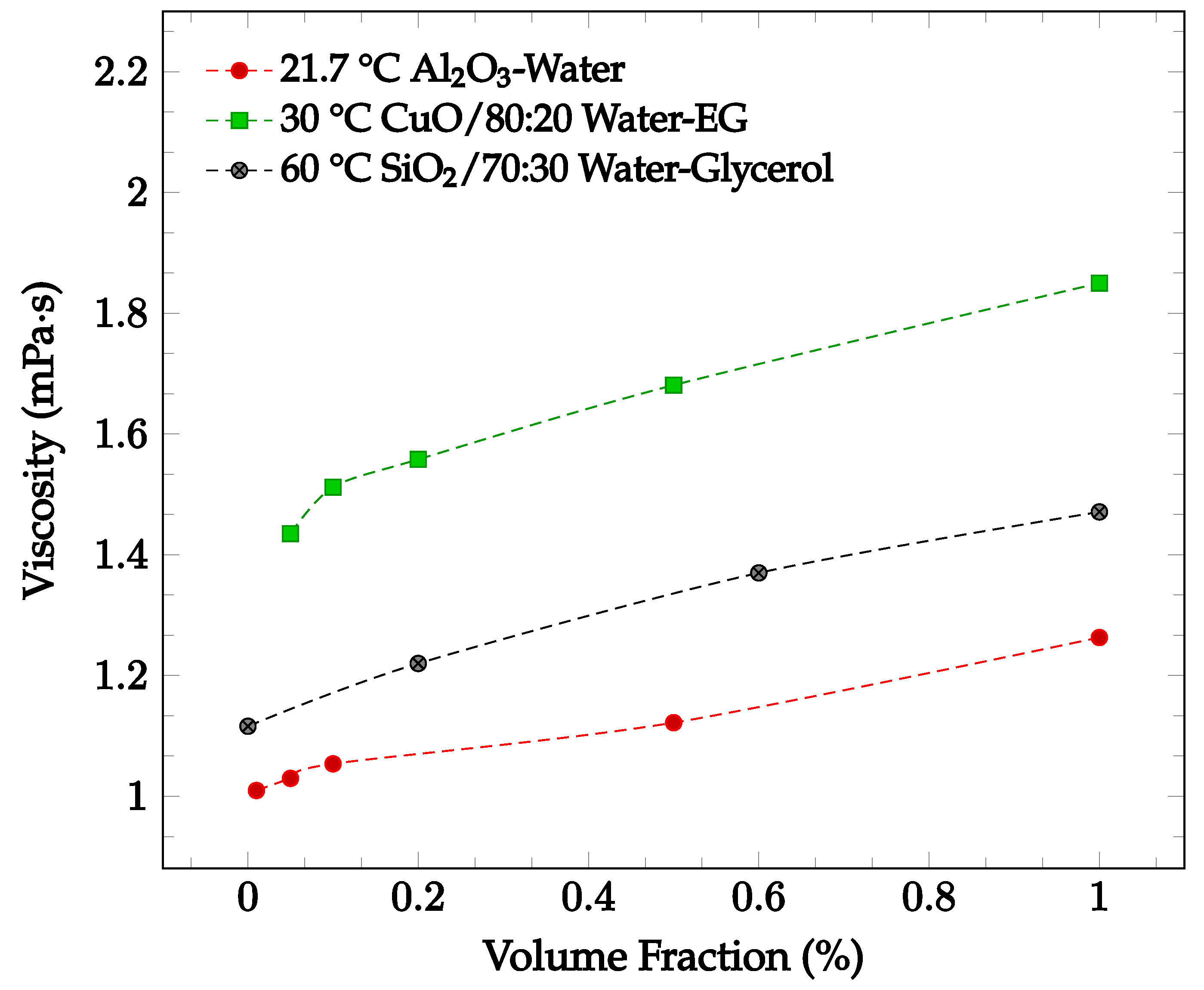



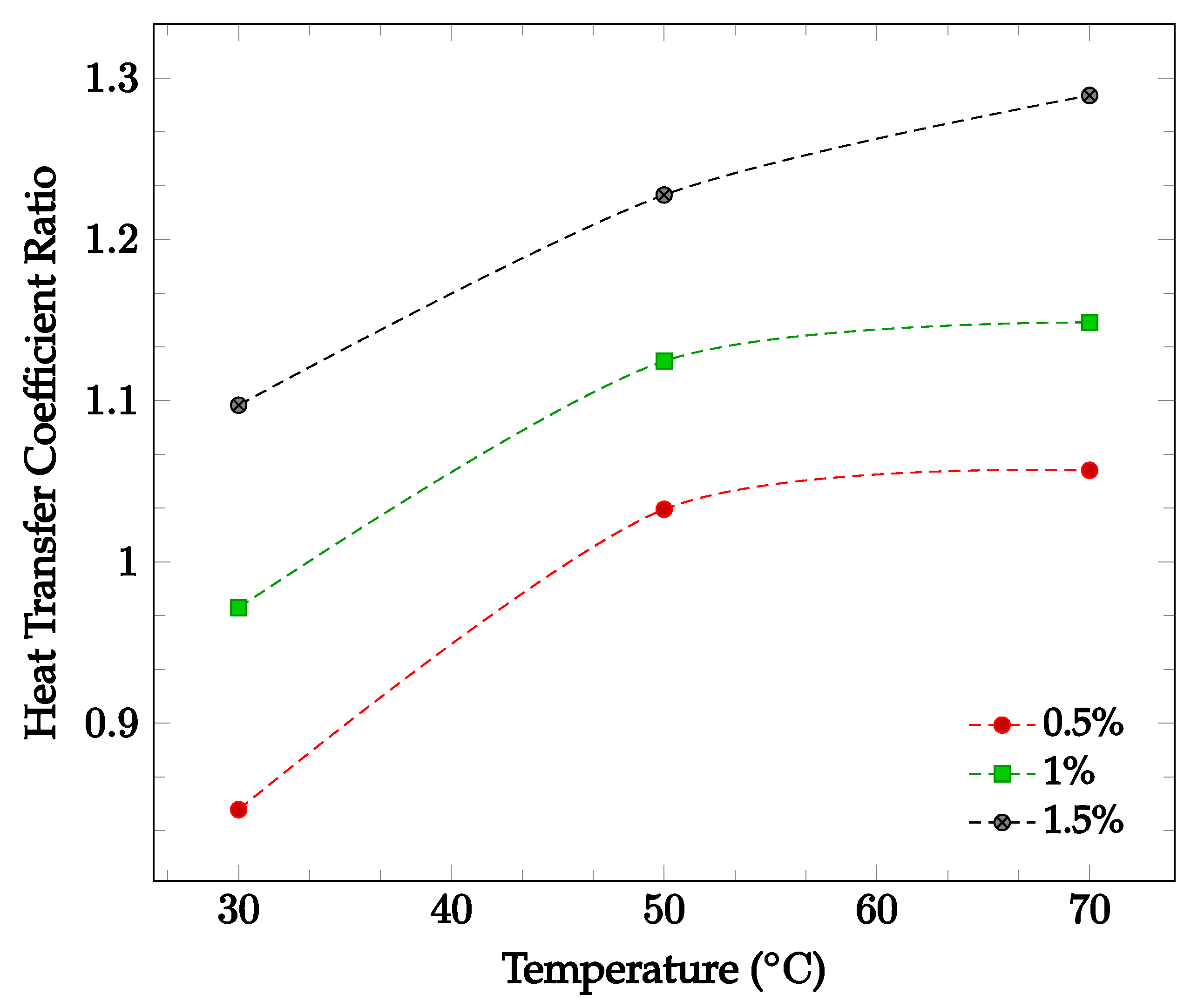
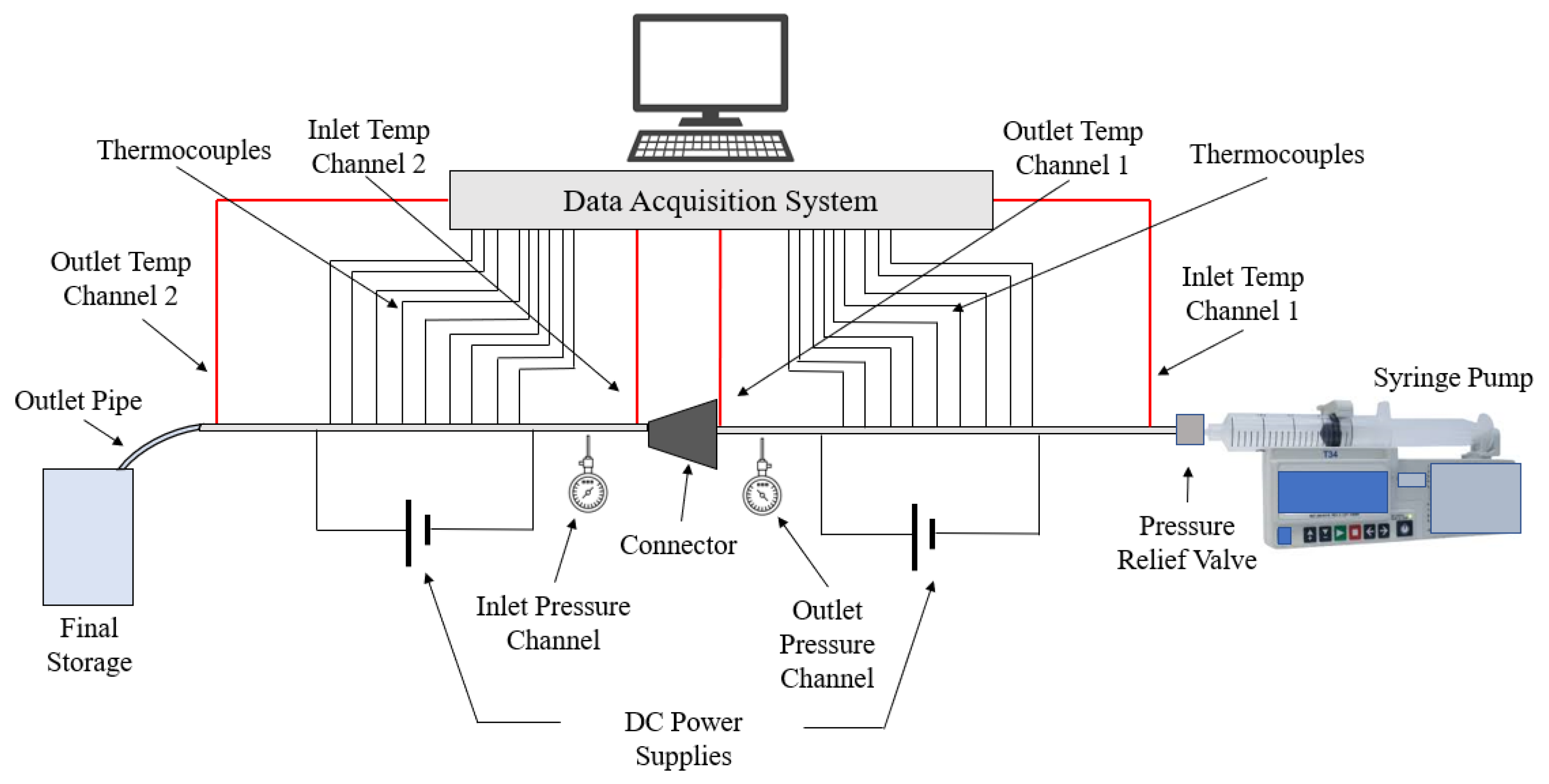
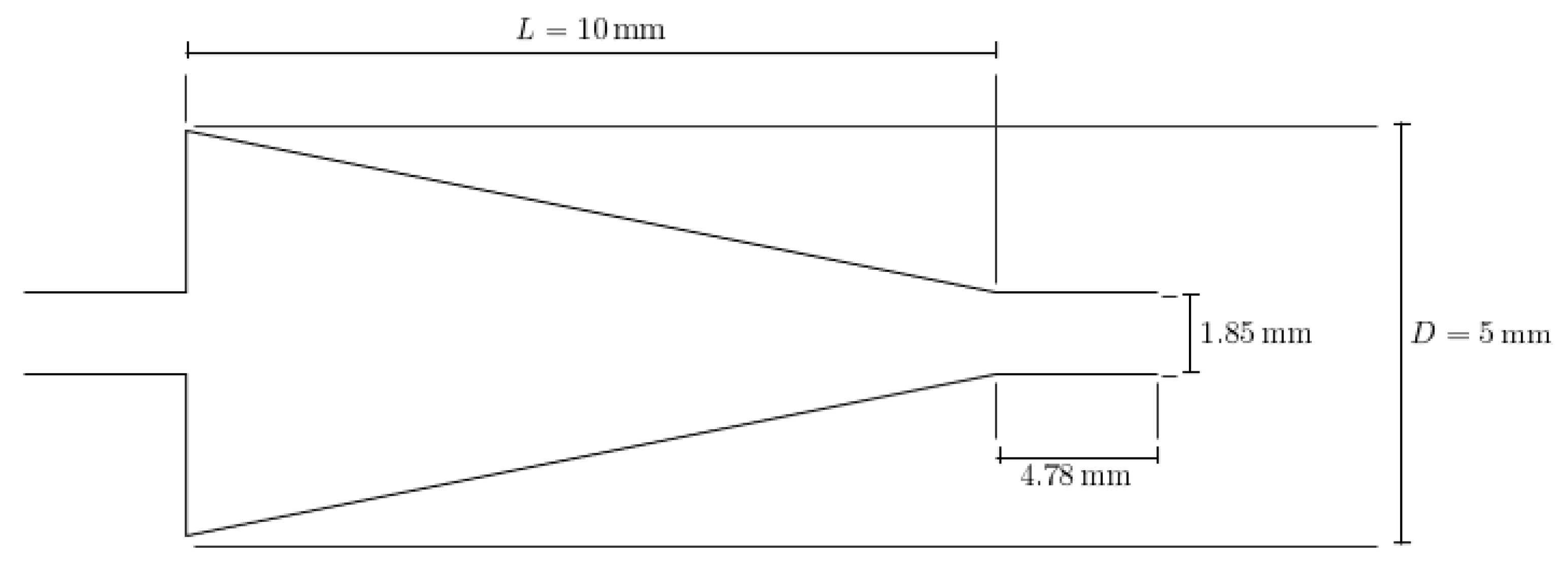
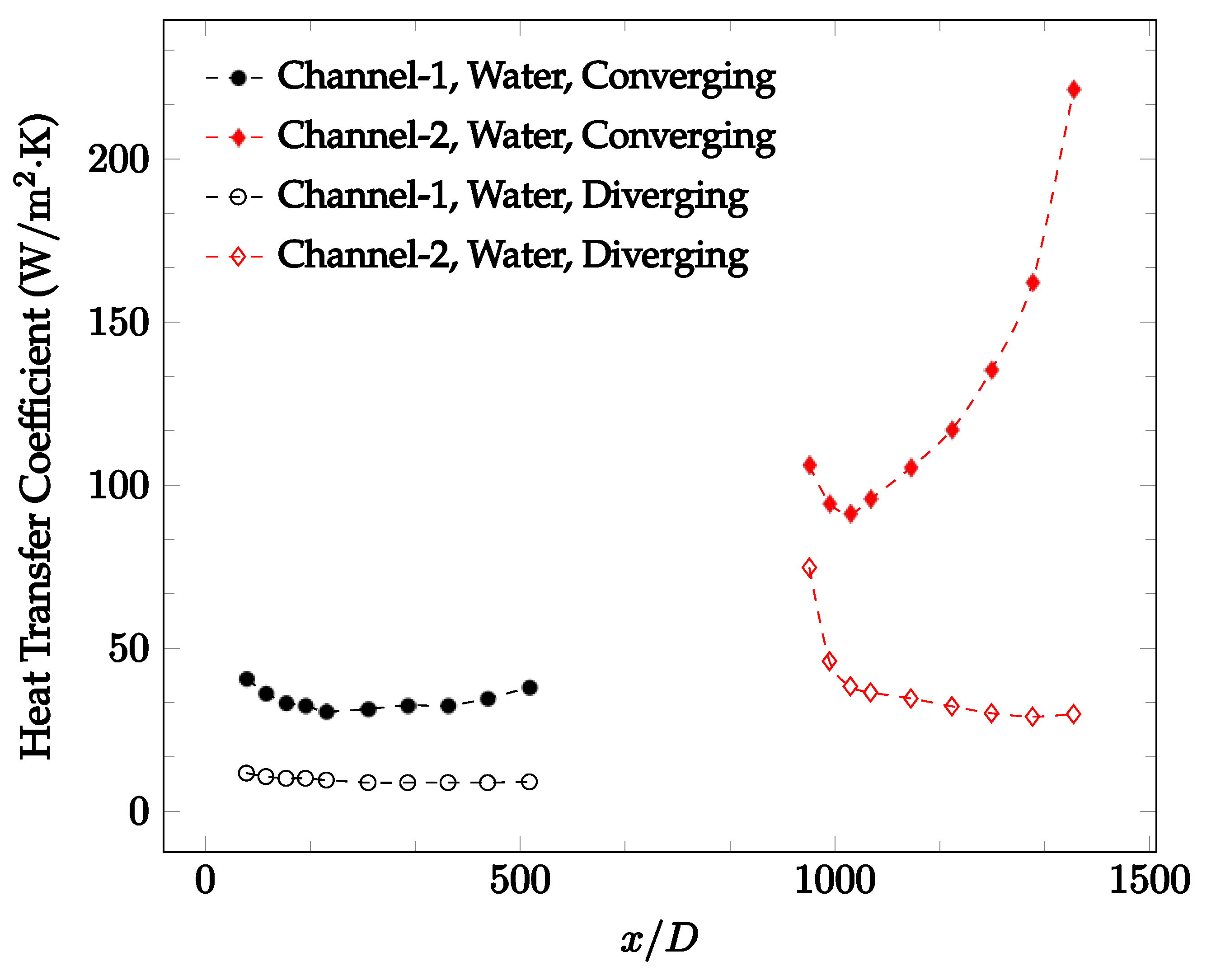
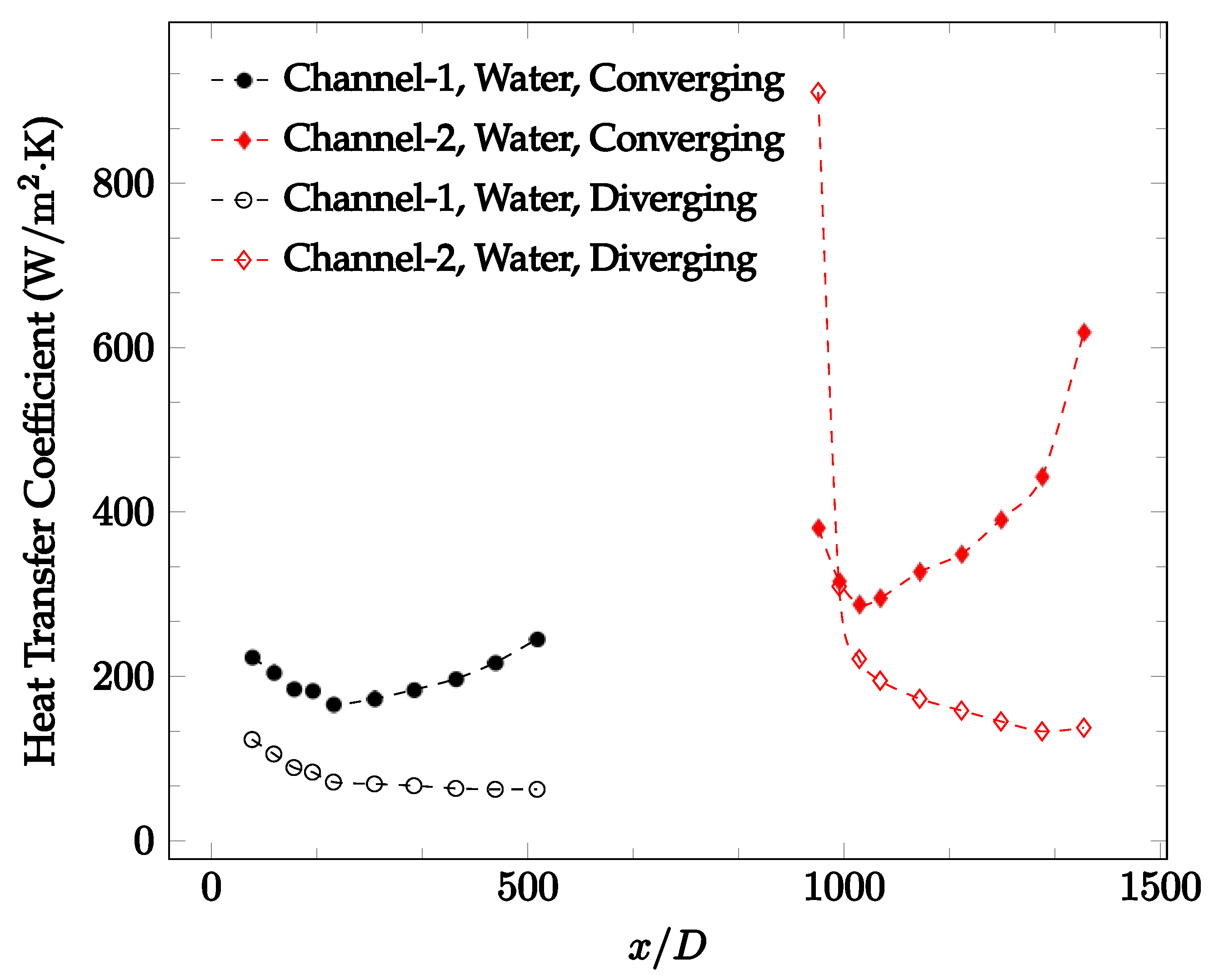
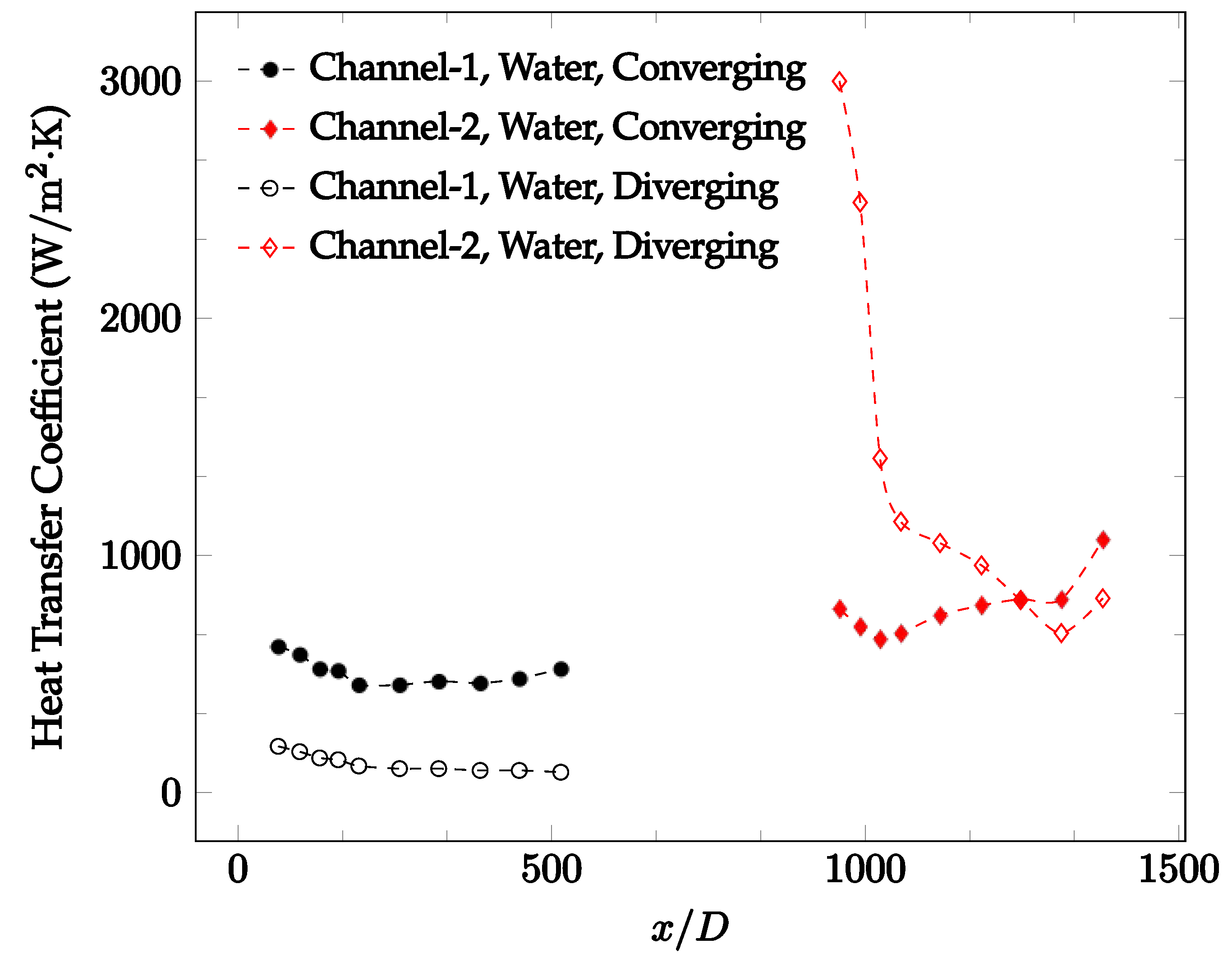
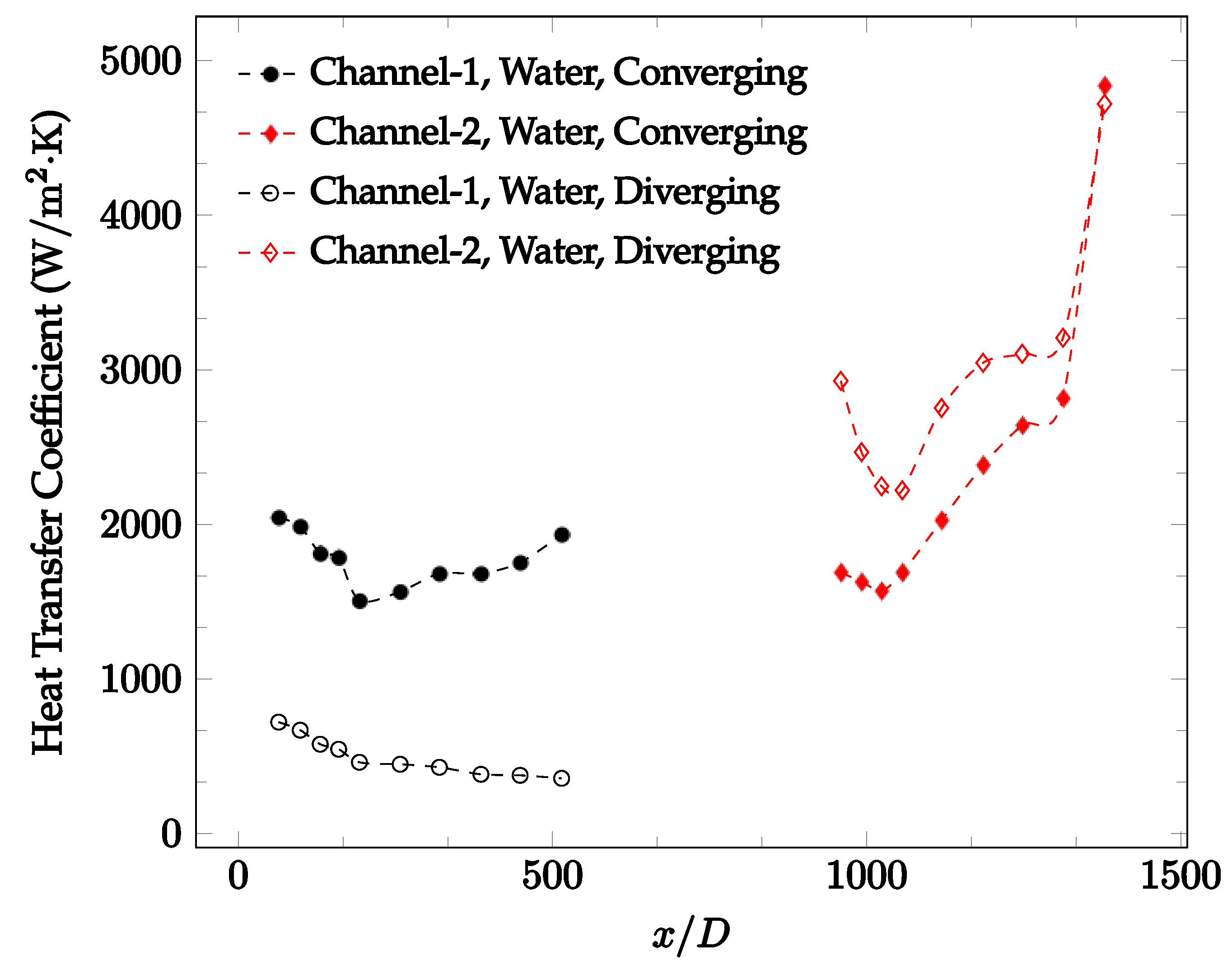
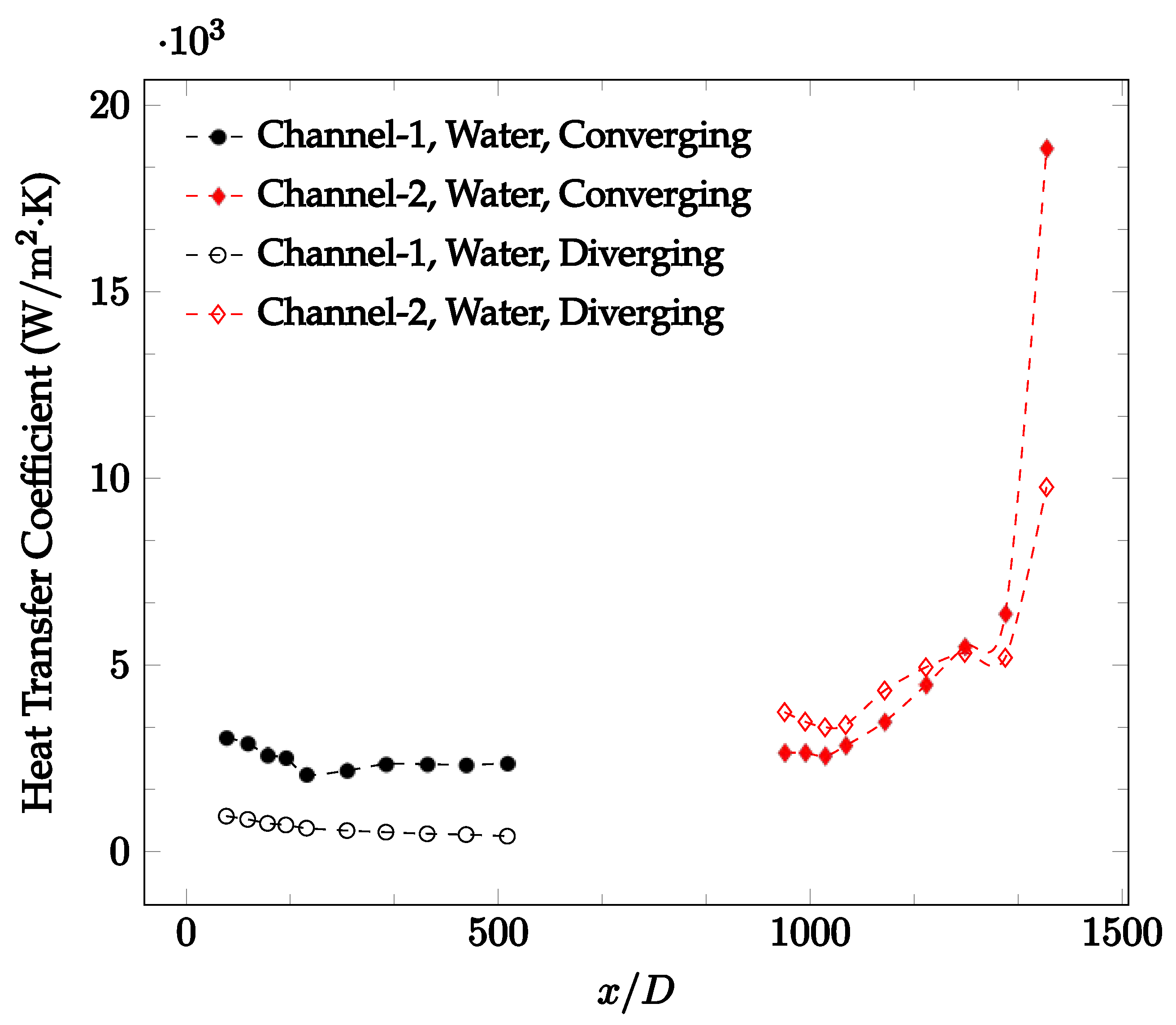

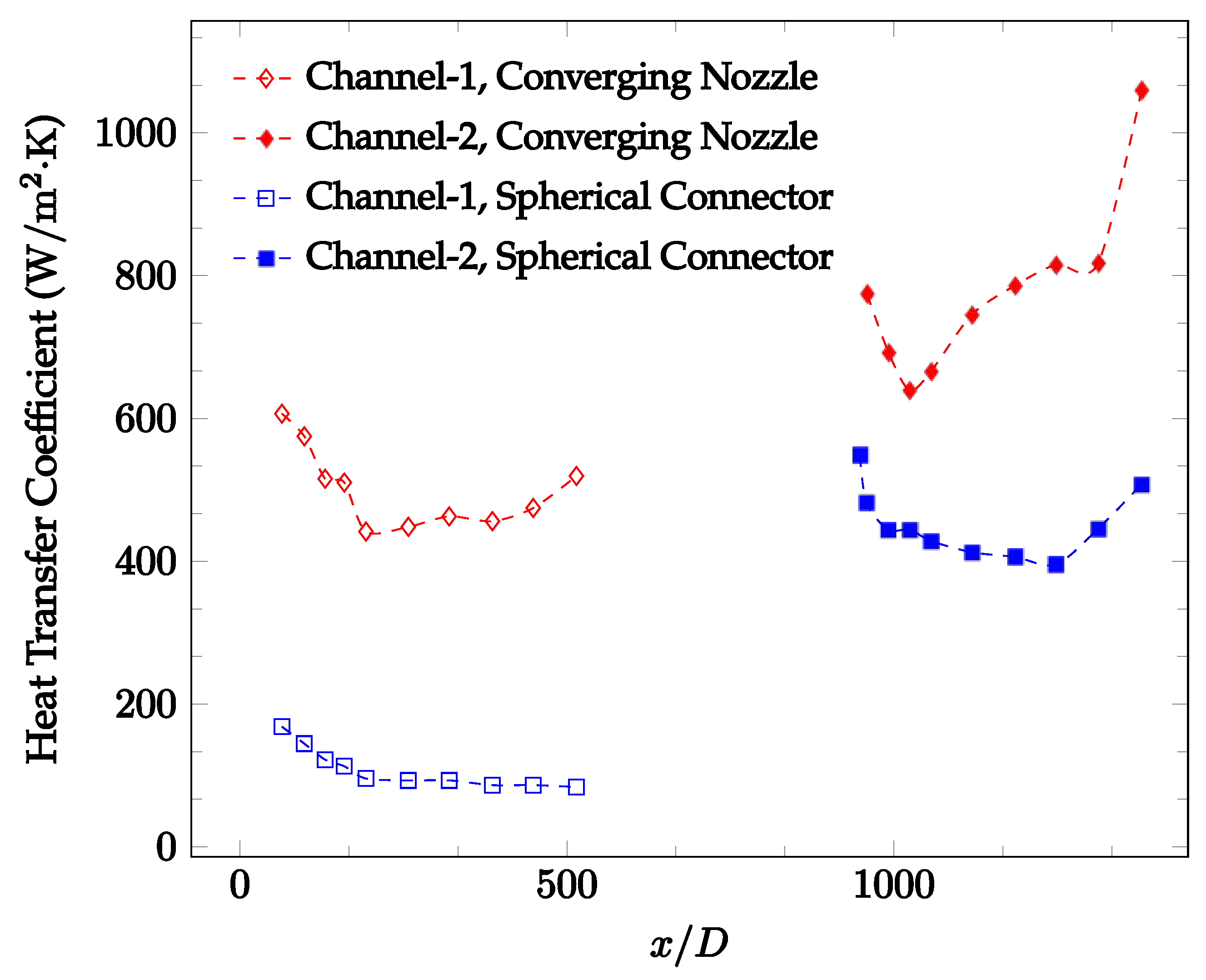
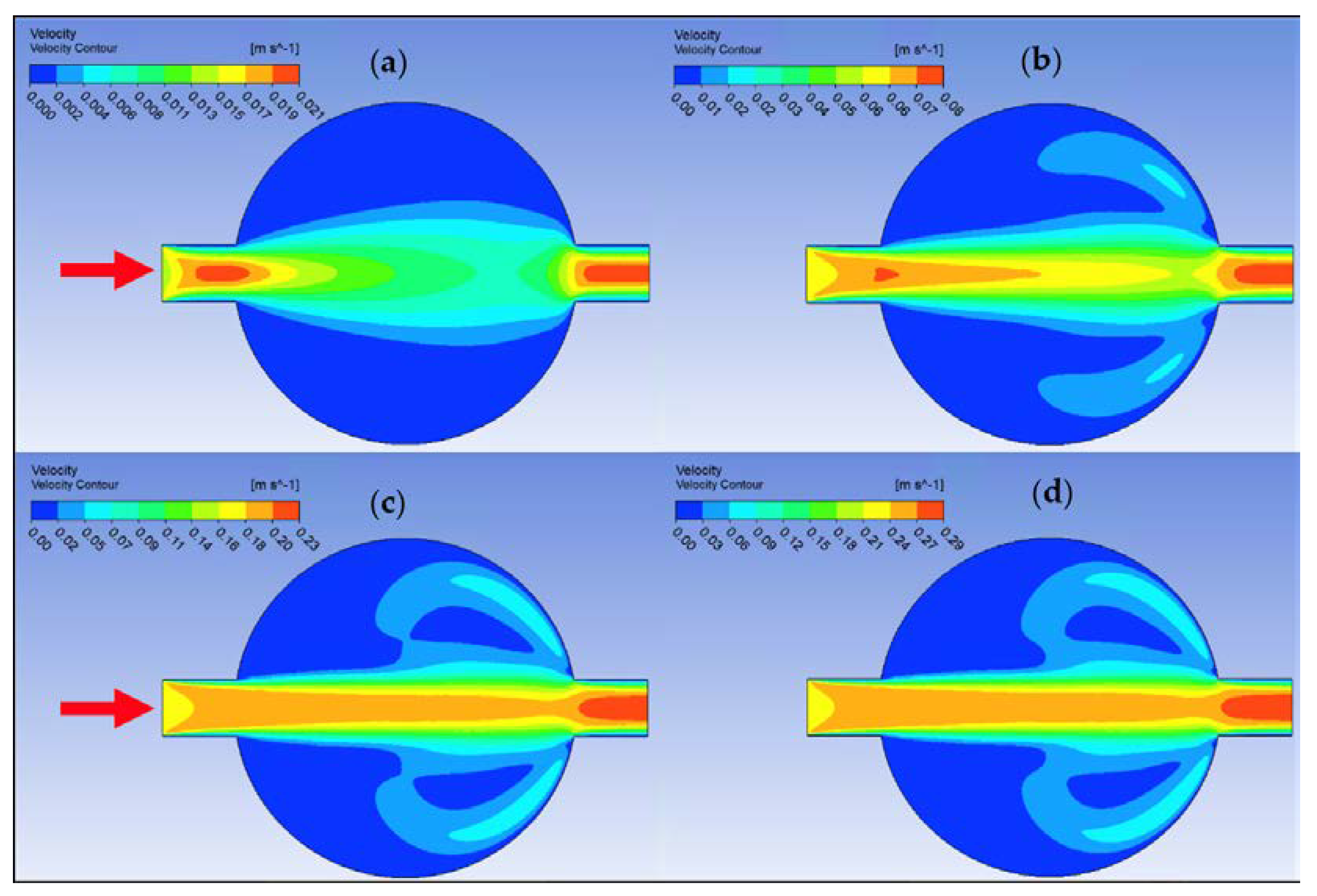
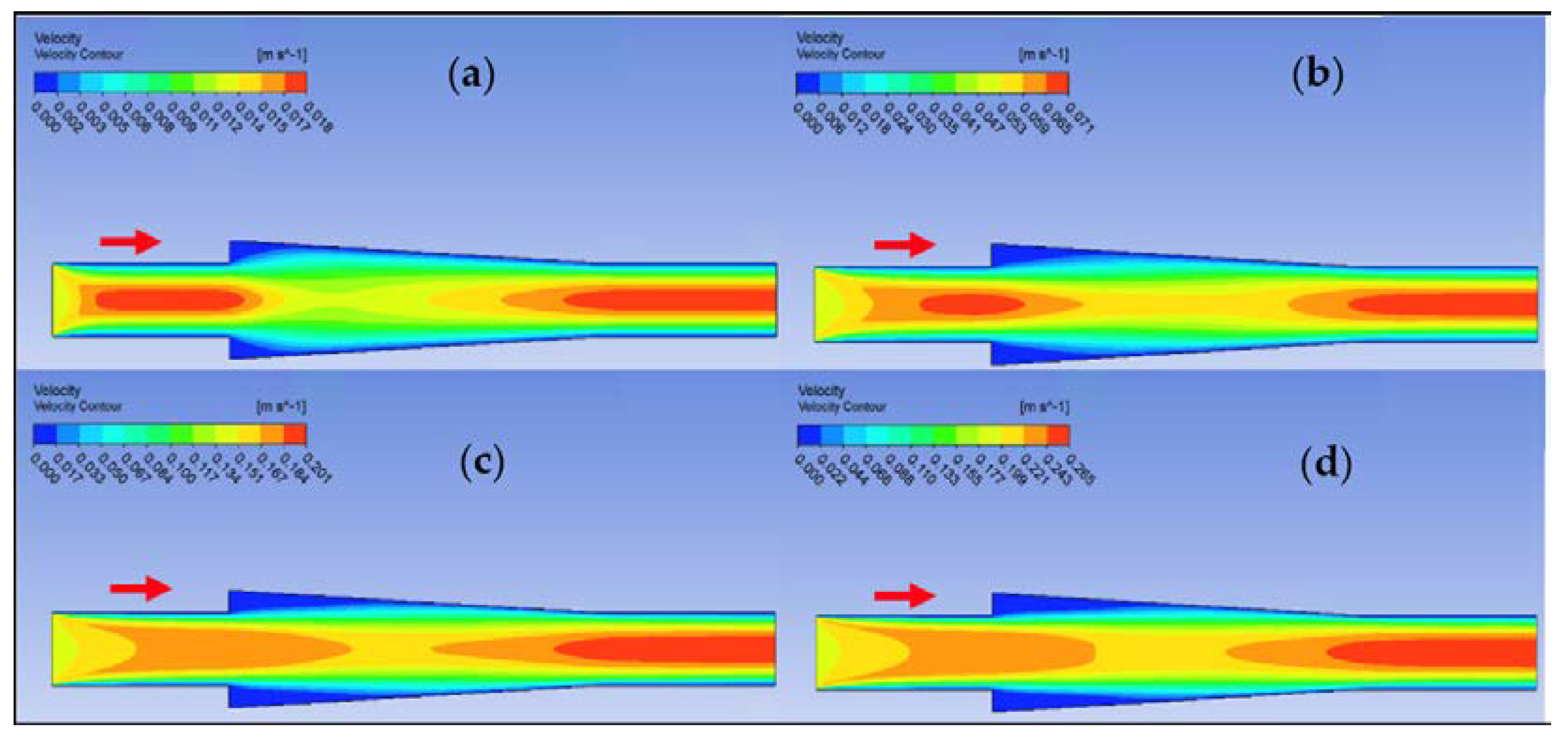
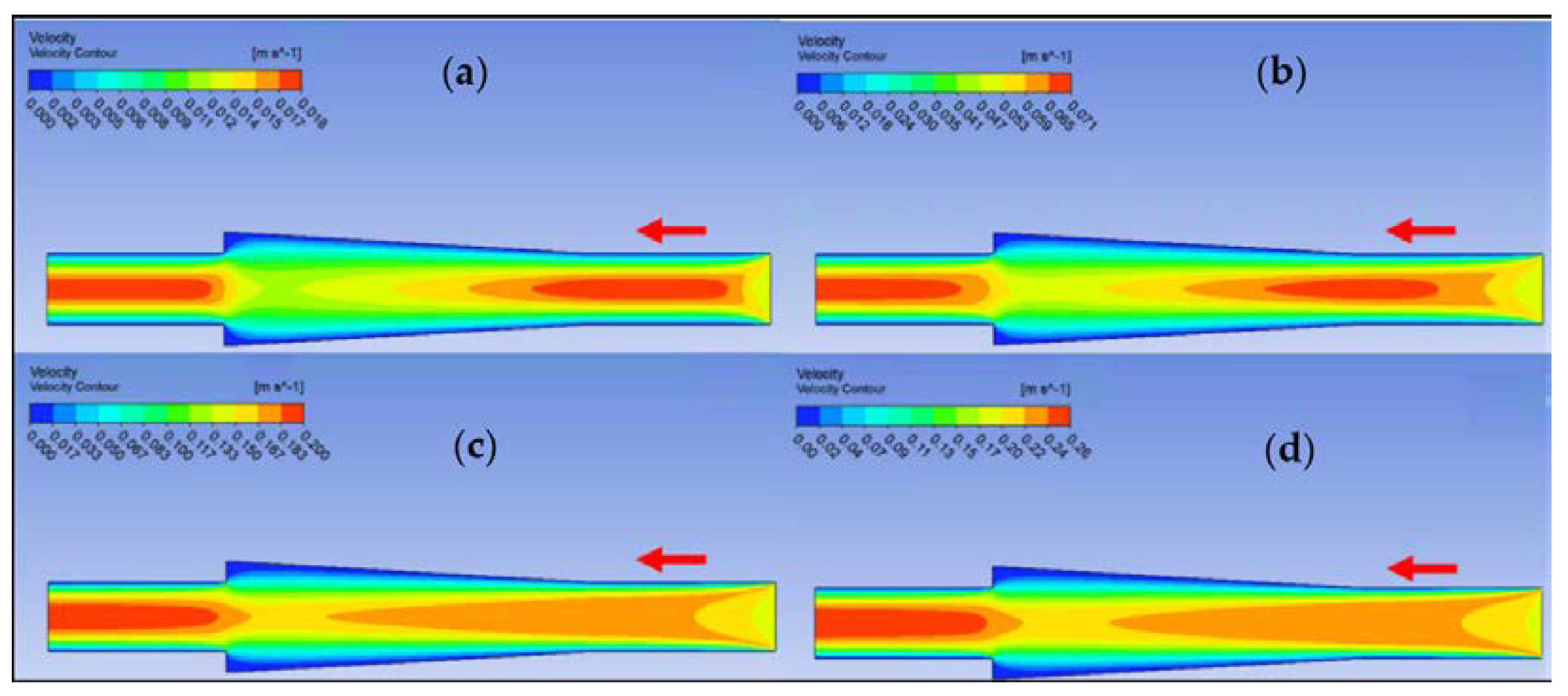
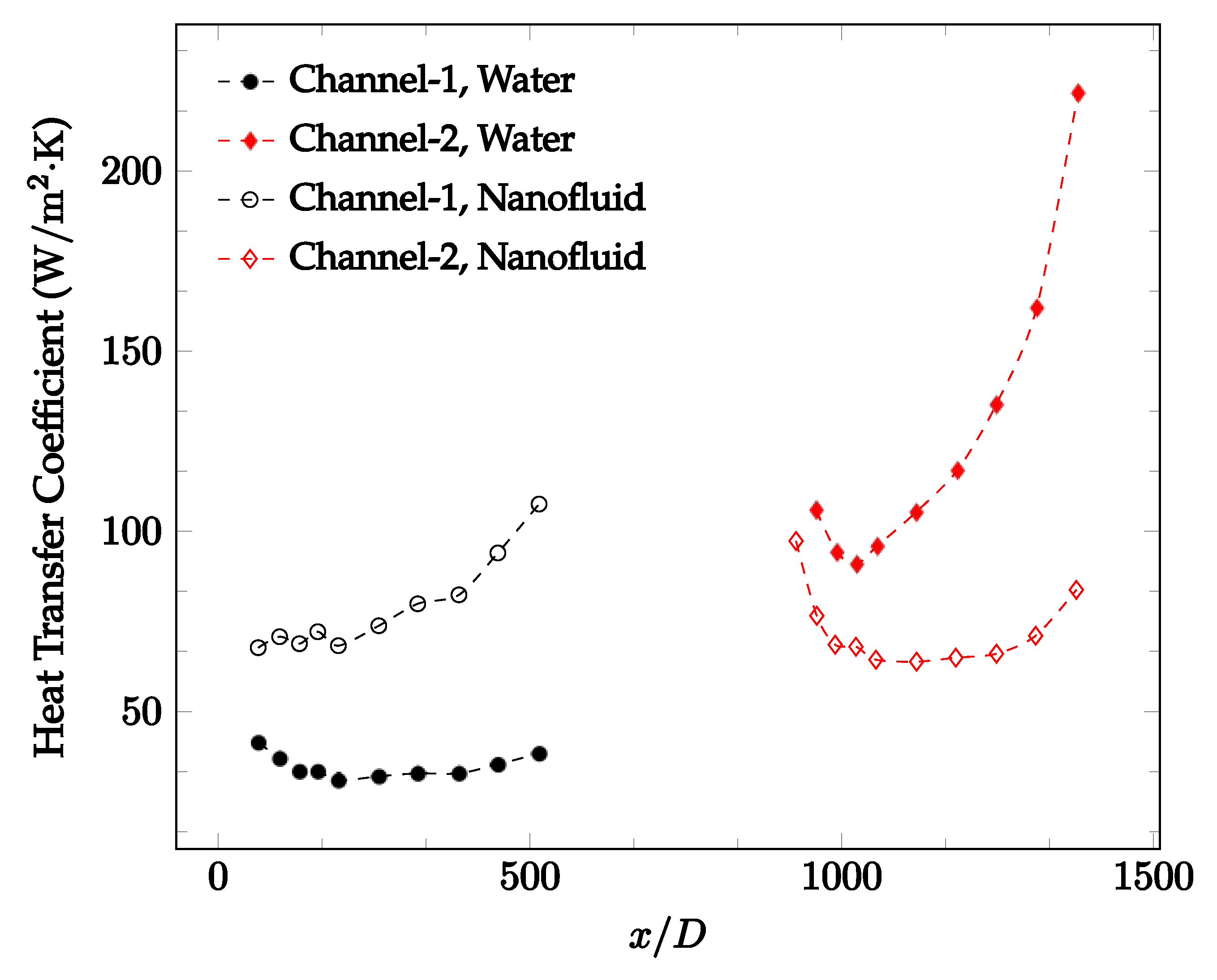

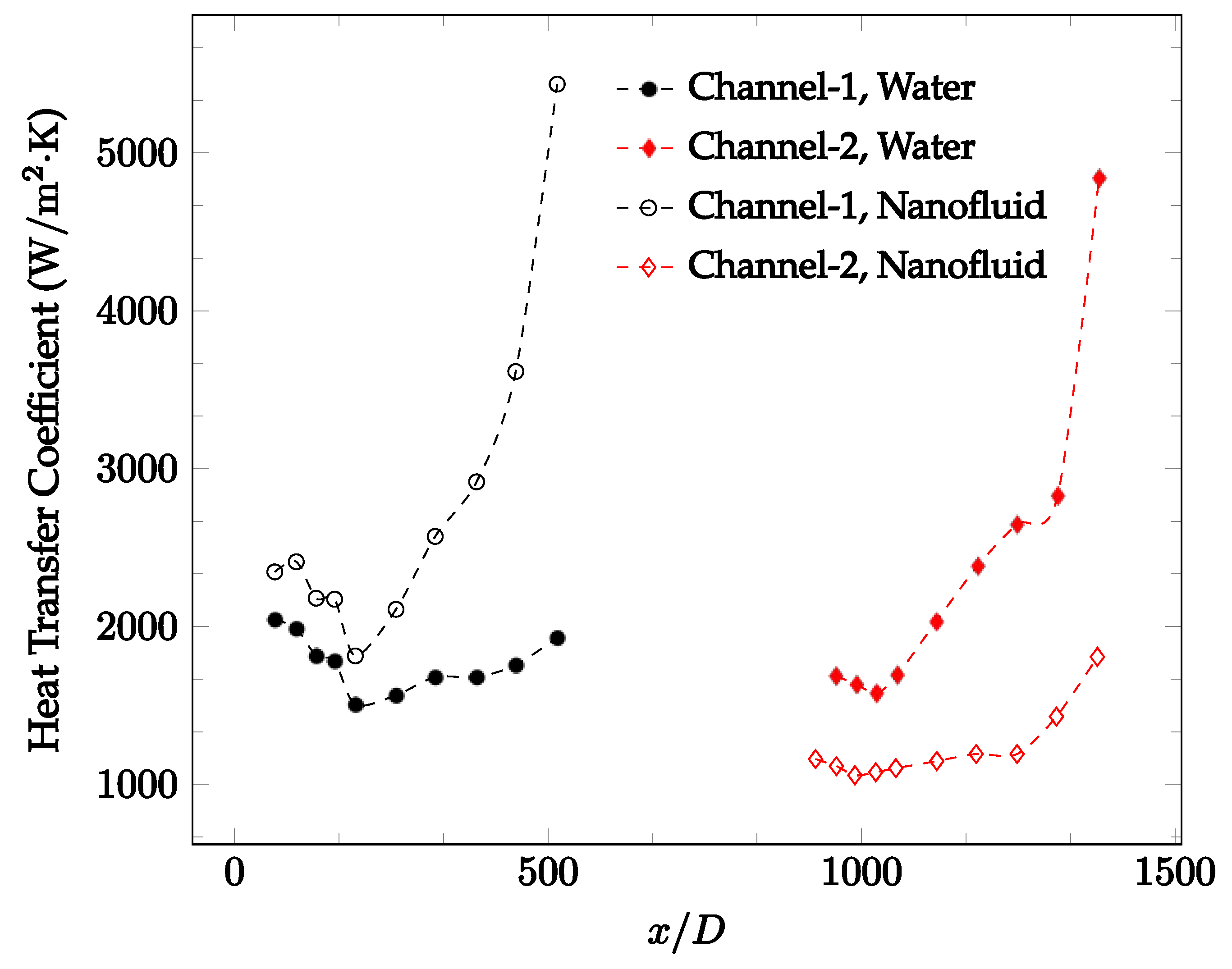
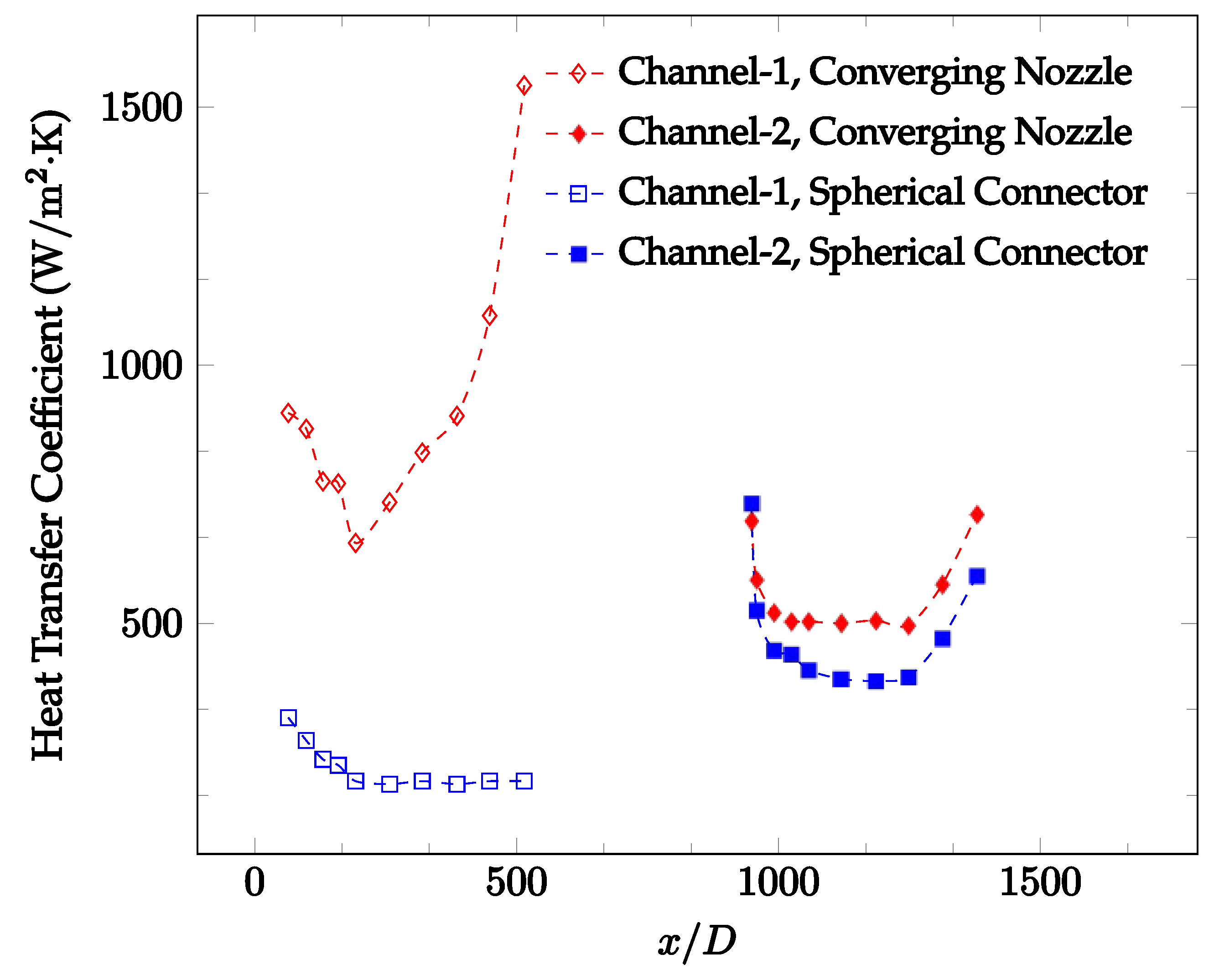
| Material | Density [kg/m3] | Specific Heat [J/kg · K] | Dynamic Viscosity [mPa · s] | Thermal Conductivity [W/m · K] |
|---|---|---|---|---|
| Fe3O4 [15] | 5810 | 670 | - | - |
| Water 1 [15] | 986.7 | 4182 | 0.523 | 0.652 |
| 1 wt% Fe3O4-water 1 [15] | 996.23 | 4174.10 | 0.41 | 0.7450 |
Publisher’s Note: MDPI stays neutral with regard to jurisdictional claims in published maps and institutional affiliations. |
© 2022 by the authors. Licensee MDPI, Basel, Switzerland. This article is an open access article distributed under the terms and conditions of the Creative Commons Attribution (CC BY) license (https://creativecommons.org/licenses/by/4.0/).
Share and Cite
Beck, J.; Palmer, M.; Inman, K.; Wohld, J.; Cummings, M.; Fulmer, R.; Scherer, B.; Vafaei, S. Heat Transfer Enhancement in the Microscale: Optimization of Fluid Flow. Nanomaterials 2022, 12, 3628. https://doi.org/10.3390/nano12203628
Beck J, Palmer M, Inman K, Wohld J, Cummings M, Fulmer R, Scherer B, Vafaei S. Heat Transfer Enhancement in the Microscale: Optimization of Fluid Flow. Nanomaterials. 2022; 12(20):3628. https://doi.org/10.3390/nano12203628
Chicago/Turabian StyleBeck, Joshua, Michael Palmer, Kallie Inman, Jake Wohld, Marcus Cummings, Ryan Fulmer, Branden Scherer, and Saeid Vafaei. 2022. "Heat Transfer Enhancement in the Microscale: Optimization of Fluid Flow" Nanomaterials 12, no. 20: 3628. https://doi.org/10.3390/nano12203628
APA StyleBeck, J., Palmer, M., Inman, K., Wohld, J., Cummings, M., Fulmer, R., Scherer, B., & Vafaei, S. (2022). Heat Transfer Enhancement in the Microscale: Optimization of Fluid Flow. Nanomaterials, 12(20), 3628. https://doi.org/10.3390/nano12203628





